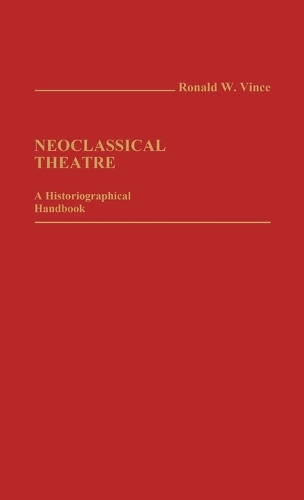
Neoclassical Theatre: A Historiographical Handbook
(Hardback)
Publishing Details
Neoclassical Theatre: A Historiographical Handbook
By (Author) Ronald W. Vince
Bloomsbury Publishing PLC
Greenwood Press
24th February 1988
United States
Classifications
Tertiary Education
Non Fiction
Theatre studies
792
Physical Properties
Hardback
239
Width 140mm, Height 216mm
595g
Description
Like Vince's two previous volumes in this series, Ancient and Medieval Theatre (1984), and Renaissance Theatre, Neoclassical Theatre provides a valuable resource for theoreticians and practioners. Choice This book provides an introduction to the information sources available to the neoclassical theatre historian and to some of the methods that have been used in the interpretation of those sources. Differences in the cultural context of the theatres in England, France, and Italy as well as in the historiography governing their interpretations are explored in depth. Unlike other books devoted to the history of eighteenth-century theatre, this work examines the materials and the processes of theatre history itself and is international in scope. Among the elements discussed are dramatic texts and promptbooks, public and legal records, playbills and account books, stage plans and scene designs, contemporary history and dramatic theory, biography and memoirs, and stage iconography and theatrical portraiture. The book also provides an evaluative sketch of some valuable reference works and, where possible, the reader is directed to a source where the original evidence is reproduced. The author concludes by examining some of the evidence for and implications of the internationalization of eighteenth-century theatre with suggestions for future study regarding the international geocultural dimension of the discipline.
Reviews
Like Vince's two previous volumes in this series (Ancient and Medieval Theatre, 1984, and Renaissance Theatre, CH, Nov 84), Neoclassical Theatre provides a valuable resource for theoreticians and practioners. In his approach to the primary sources and the major interpretations of this 'major but circumscribed aspect' of 18th century Europe, Vince draws from a rich assortment of texts, theatrical designs, public records, playbills, critics, prompt books, and memoirs. Although he clearly details the scholarship in both commentary and bibliography, he fortunately does not practice 'historiography' as a dispassionate summary. His opinions are recorded with energy, and readers are encouraged to consult the sources to form their own interpretations. Throughout, Vince reminds his audience of two primary challenges: the aspects of the neoclassical theater that wait to be examined, and the limitations inherent when dramatic criticism is artificially separated from theatrical history.-Choice
This is the third in a series of sources on theatre history that provides an introduction to the sources of information available to the theatre historian, and to some of the methods that have been used in the interpretation of the sources.' Information is thus presented on dramatic texts and prompt books, public and legal records, playbills and account books, stage plans and stage designs, contemporary history and dramatic theory, biography and memoirs, stage, iconography and theatrical portraiture. There are four chapters: The English Theatre, 1642-1800; The Theatre of Eighteenth-Century France; The Theatre of Eighteenth-Century Italy; and The Internationalization of Eighteenth-Century Theatre: A Miscellany. Each chapter opens with a historical overview, followed by a survey of recent criticism of the subject, then a survey of criticism of the past, information on the various sources of the times, as listed above, and finally, a lengthy bibliography. Index. One could not ask for a more thorough yet readable reference on the subject. Recommended for all large theatre reference collections.-Reference Book Review
"Like Vince's two previous volumes in this series (Ancient and Medieval Theatre, 1984, and Renaissance Theatre, CH, Nov 84), Neoclassical Theatre provides a valuable resource for theoreticians and practioners. In his approach to the primary sources and the major interpretations of this 'major but circumscribed aspect' of 18th century Europe, Vince draws from a rich assortment of texts, theatrical designs, public records, playbills, critics, prompt books, and memoirs. Although he clearly details the scholarship in both commentary and bibliography, he fortunately does not practice 'historiography' as a dispassionate summary. His opinions are recorded with energy, and readers are encouraged to consult the sources to form their own interpretations. Throughout, Vince reminds his audience of two primary challenges: the aspects of the neoclassical theater that wait to be examined, and the limitations inherent when dramatic criticism is artificially separated from theatrical history."-Choice
"This is the third in a series of sources on theatre history that provides an introduction to the sources of information available to the theatre historian, and to some of the methods that have been used in the interpretation of the sources.' Information is thus presented on dramatic texts and prompt books, public and legal records, playbills and account books, stage plans and stage designs, contemporary history and dramatic theory, biography and memoirs, stage, iconography and theatrical portraiture. There are four chapters: The English Theatre, 1642-1800; The Theatre of Eighteenth-Century France; The Theatre of Eighteenth-Century Italy; and The Internationalization of Eighteenth-Century Theatre: A Miscellany. Each chapter opens with a historical overview, followed by a survey of recent criticism of the subject, then a survey of criticism of the past, information on the various sources of the times, as listed above, and finally, a lengthy bibliography. Index. One could not ask for a more thorough yet readable reference on the subject. Recommended for all large theatre reference collections."-Reference Book Review
Author Bio
RONALD W. VINCE is Professor of English and a Member of the Instruction Committee on Dramatic Arts at McMaster University in Hamilton, Ontario.
